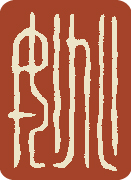Flowering and Fruit Set
In the spring the Napa Valley bursts with color. Warming temperatures bring out the golden blossoms of the California poppy and the blue towers of lupine. Crimson clover dots the hillsides and the deep yellow of mustard lines the rows of grapevines. Napa enjoys a Mediterranean climate which includes a fairly dry winter, but with the spring rains the hills have turned green, as have the grapevines themselves as they leaf out. The buds that carry this year's grape crop push open and stalks of leaves, tendrils, and flowers grow toward the light.
Grape flowers are, to be kind, unprepossessing. They appear roughly 40 to 80 days after bud break, when the first shoots of the growing season appear. New leaves are powering the sun's energy through the vines, turning sunlight to sugar and providing the food the leaves, vines, and grapes need.
The flowers themselves first appear as small, button-like clusters. Each flower is hidden within a fused cap of petals, called the calyptras. The cap is shed, revealing the blossom within. It looks like an asterisk: a rounded pistil or ovary with the stigma centered atop it, surrounded by delicate white stamen supporting the pale anthers. The entire flower is tiny, but they grow in clusters so that a flowering grapevine seems to have long, fuzzy plumes leaning out from the stalks. Each different type of grape's blossoms has a different scent, very light and delicate but distinct. It is during this time that the buds that will form next year's crop begin to develop.
Most vitis vinifera vines have both male stamens and female pistils, and are able to self-pollinate. Because of the tight clustering of the grape blossoms, wind and insects tend to play a small part in pollination, although cross-pollination is possible. In fact, Cabernet Sauvignon, a grape and wine that provide the backbone of Napa's wine industry, was a cross-pollination of Cabernet Franc and Sauvignon blanc.
Cold, wind, and rain can all disrupt pollination, leaving flowers unfertilized and disrupting the formation of grape clusters. This stage determines the yield of the potential crop. Not every flower is fertilized: average fertilization rates vary between 30 and 60 percent, but can be much lower. Luckily, as spring advances the rains lighten and fall away into the yearly summer drought, but the vineyard manager still has much to be concerned about.
The fertilized pistils produce seeds which are encapsulated as the grape berries form around them. This process, called "fruit set," beings almost immediately after flowering; in the Napa Valley this generally happens in May. Now the vineyard manager must pay close attention to humidity and temperatures, to water stress and the balance of carbohydrate levels. At times a fruit will form with no seeds, which leads to smaller grape berries; at other times a cluster will have both large and small berries, which create problems later on because of varying "skin to pulp" ratios. Vine diseases such as fanleaf, or mineral deficiencies in the vine, adversely affect the crop.
Spring is a busy and bothersome time, for both the grapevines and the humans who tend them.
- Jay Behmke, President, Yao Family Wines


